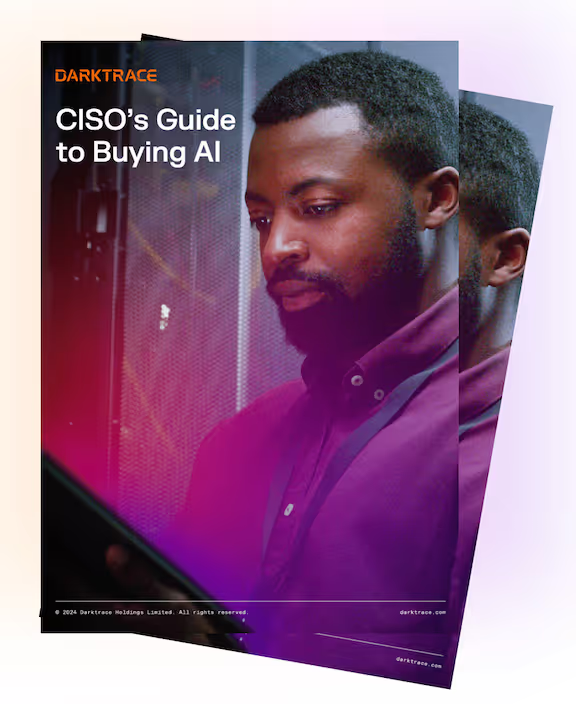Enterprise AI tools go mainstream
In this dawning Age of AI, CISOs are increasingly exploring investments in AI security tools to enhance their organizations’ capabilities. AI can help achieve productivity gains by saving time and resources, mining intelligence and insights from valuable data, and increasing knowledge sharing and collaboration.
While investing in AI can bring immense benefits to your organization, first-time buyers of AI cybersecurity solutions may not know where to start. They will have to determine the type of tool they want, know the options available, and evaluate vendors. Research and understanding are critical to ensure purchases are worth the investment.
Challenges of a muddied marketplace
Key challenges in AI purchasing come from consumer doubt and lack of vendor transparency. The AI software market is buzzing with hype and flashy promises, which are not necessarily going to be realized immediately. This has fostered uncertainty among potential buyers, especially in the AI cybersecurity space.
As Gartner writes, “There is a general lack of transparency and understanding about how AI-enhanced security solutions leverage AI and the effectiveness of those solutions within real-world SecOps. This leads to trust issues among security leaders and practitioners, resulting in slower adoption of AI features” [1].
Similarly, only 26% of security professionals report a full understanding of the different types of AI in use within security products.
Given this widespread uncertainty generated through vague hype, buyers must take extra care when considering new AI tools to adopt.
Goals of AI adoption
Buyers should always start their journeys with objectives in mind, and a universal goal is to achieve return on investment. When organizations adopt AI, there are key aspects that will signal strong payoff. These include:
- Wide-ranging application across operations and areas of the business
- Actual, enthusiastic adoption and application by the human security team
- Integration with the rest of the security stack and existing workflows
- Business and operational benefits, including but not limited to:
- Reduced risk
- Reduced time to response
- Reduced potential downtime, damage, and disruption
- Increased visibility and coverage
- Improved SecOps workflows
- Decreased burden on teams so they can take on more strategic tasks
Ideally, most or all these measurements will be fulfilled. It is not enough for AI tools to benefit productivity and workflows in theory, but they must be practically implemented to provide return on investment.
Investigation before investment
Before investing in AI tools, buyers should ask questions pertaining to each stage of the adoption journey. The answers to these questions will not only help buyers gauge if a tool could be worth the investment, but also plan how the new tool will practically fit into the organization’s existing technology and workflows.

These questions are good to imagine how a tool will fit into your organization and determine if a vendor is worth further evaluation. Once you decide a tool has potential use and feasibility in your organization, it is time to dive deeper and learn more.
Ask vendors specific questions about their technology. This information will most likely not be on their websites, and since it involves intellectual property, it may require an NDA.
Find a longer list of questions to ask vendors and what to look for in their responses in the white paper “CISO’s Guide to Buying AI.”
Committing to transparency amidst the AI hype
For security teams to make the most out of new AI tools, they must trust the AI. Especially in an AI marketplace full of hype and obfuscation, transparency should be baked into both the descriptions of the AI tool and the tool’s functionality itself. With that in mind, here are some specifics about what techniques make up Darktrace’s AI.
Darktrace as an AI cybersecurity vendor
Darktrace has been using AI technology in cybersecurity for over 10 years. As a pioneer in the space, we have made innovation part of our process.
The Darktrace ActiveAI Security Platform™ uses multi-layered AI that trains on your unique business operations data for tailored security across the enterprise. This approach ensures that the strengths of one AI technique make up for the shortcomings of another, providing well-rounded and reliable coverage. Our models are always on and always learning, allowing your team to stop attacks in real time.
The machine learning techniques used in our solution include:
- Unsupervised machine learning
- Multiple Clustering Techniques
- Multiple anomaly detection models in tandem analyzing data across hundreds of metrics
- Bayesian probabilistic methods
- Bayesian metaclassifier for autonomous fine-tuning of unsupervised machine learning models
- Deep learning engines
- Graph theory
- Applied supervised machine learning for investigative AI
- Neural networks
- Reinforcement Learning
- Generative and applied AI
- Natural Language Processing (NLP) and Large Language Models (LLMs)
- Post-processing models
Additionally, since Darktrace focuses on using the customer’s data across its entire digital estate, it brings a range of advantages in data privacy, interpretability, and data transfer costs.
Building trust with Darktrace AI
Darktrace further supports the human security team’s adoption of our technology by building trust. To do that, we designed our platform to give your team visibility and control over the AI.
Instead of functioning as a black box, our products focus on interpretability and sharing confidence levels. This includes specifying the threshold of what triggered a certain alert and the details of the AI Analyst’s investigations to see how it reached its conclusions. The interpretability of our AI uplevels and upskills the human security team with more information to drive investigations and remediation actions.
For complete control, the human security team can modify all the detection and response thresholds for our model alerts to customize them to fit specific business preferences.
Conclusion
CISO’s are increasingly considering investing in AI cybersecurity tools, but in this rapidly growing field, it’s not always clear what to look for.
Buyers should first determine their goals for a new AI tool, then research possible vendors by reviewing validation and asking deeper questions. This will reveal if a tool is a good match for the organization to move forward with investment and adoption.
As leaders in the AI cybersecurity industry, Darktrace is always ready to help you on your AI journey.

How to evaluate an AI cybersecurity vendor
Download the white paper to learn how buyers should approach purchasing AI-based solutions. It includes:
- Key steps for selecting AI cybersecurity tools
- Questions to ask and responses to expect from vendors
- Understand tools available and find the right fit
- Ensure AI investments align with security goals and needs
References
- Gartner, April 17, 2024, “Emerging Tech: Navigating the Impact of AI on SecOps Solution Development.”
- Inspired by Gartner, May 14, 2024, “Presentation Slides: AI Survey Reveals AI Security and Privacy Leads to Improved ROI” and NHS England, September, 18, 2020, “A Buyer’s Guide to AI in Health and Care,” Available at: https://transform.england.nhs.uk/ai-lab/explore-all-resources/adopt-ai/a-buyers-guide-to-ai-in-health-and-care/
































.jpeg)






